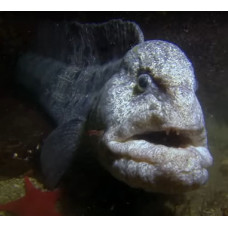Latin name
Anarrhichthys ocellatus
Other names
Anarrhichthys ocellatus
Identification
Body elongated, eel-shaped, covered with fine cycloid scales. Head massive, relatively small, with rounded snout. One nostril on each side of the head. Both jaws have several rows of teeth, the first rows are fang-like, the rest are molar-shaped, blunt, with cusps at the ends. There is no lateral line. There is no swim bladder.
Features of fish fins
The dorsal fin is very long, running the length of the body, with 218-250 unbranched flexible rays. The long anal fin has 180-233 soft rays. Pectoral fins are large, with rounded edges and 18-24 rays. Pelvic fins are absent. The caudal fin is fused with the dorsal and anal fins.
Fish colouring
Body coloration is gray, sometimes dark green. Dark spots are scattered over the body. There are also spots on the dorsal and pectoral fins.
Distribution
Widespread in the North Pacific. They are found in the Sea of Japan, Sea of Okhotsk, Bering Sea, Aleutian Islands, Gulf of Alaska and as far south as the coast of Southern California.
Habitat
Demersal territorial fish inhabiting shallow coastal waters, occasionally found at depths down to 226 m. They hold over rocky substrates with numerous shelters. Juveniles inhabit the pelagic zone for the first two years of their lives.
Size
The maximum length is 240 cm and the mass is 18.4 kg.
Behavior
During the day, they hide in shelters, which they guard closely. They are active at night. Adults seek shelter among rocks in intertidal areas and occupy the same shelter until displaced by larger eels or octopuses.
Food and feeding habits
The diet includes crustaceans, mollusks, echinoderms, and sometimes fish.
Reproduction
During courtship, the male wolf eel places his head against the female's abdomen, wraps around her, and fertilizes her eggs as she pushes them out. During oviposition, both the male and female wrap themselves around the egg mass to protect it. The female periodically turns the eggs over until the chicks hatch. The male and female can mate for life. They first mature at 4 years of age. Spawning occurs from October to the end of winter. Females can lay up to 10,000 eggs. Eggs are bottom-feeding and are grouped into clutches. Both parents will guard the clutch.
Fishing
Have little commercial importance in the fishery.
Relationship with a person
Injury-prone species for humans. Large individuals can inflict a painful bite. These fish have very tasty meat. Used in public aquariums.
| Classification | |
| Phylum | Chordata |
| Class | Actinopterygii |
| Squad | Scorpaeniformes |
| Family | Anarhichadidae |
| Genus | Anarrhichthys |
| Species | A. ocellatus |
| Features | |
| Conservation status | Least Concern |
| Habitat | Pelagic |
| Life span, years | No information |
| Maximum body weight, kg | 18,4 |
| Maximum length, cm | 240 |
| Sailing speed, m/s | No information |
| Threat to people | Edible |
| Way of eating | Predator |
Wolf eel
Tags: wolf eel



